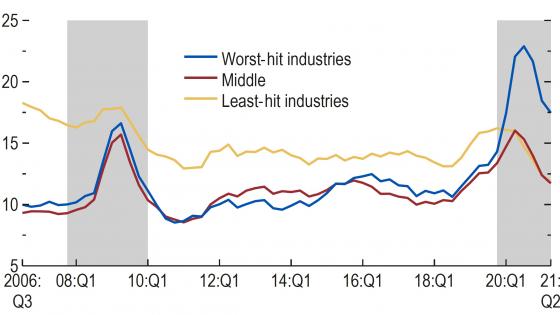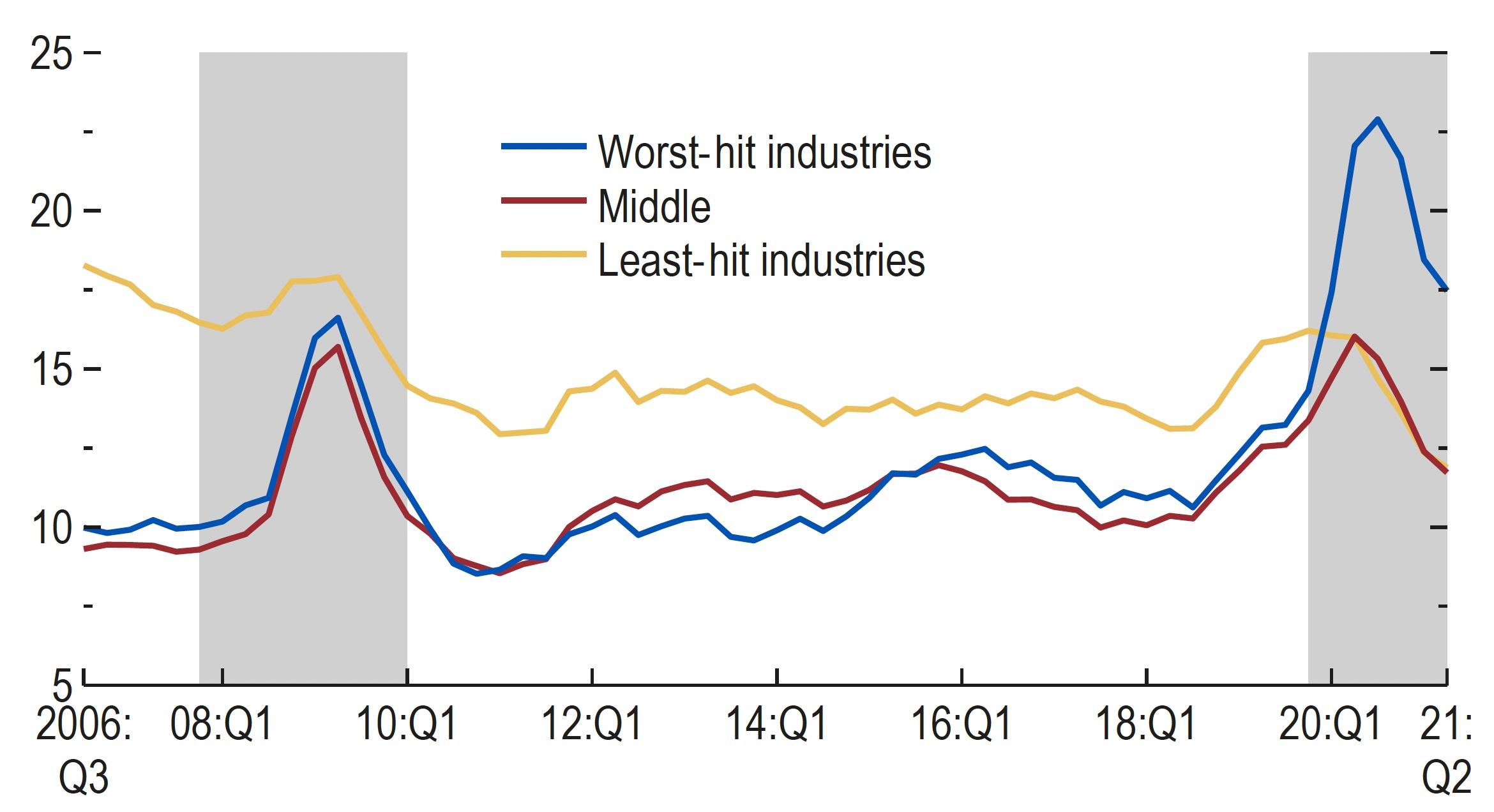The unprecedented fiscal and monetary support to the non-financial corporate sector during the pandemic staved off a deeper recession in 2020. Measures such as loans, credit guarantees, and moratoriums on debt repayment have been pivotal in preventing widespread corporate failures and related employment and output losses (Gourinchas et al. 2021). However, the resulting build-up of firms’ leverage, which increased by almost 10% globally, may affect the pace of the recovery.
Debt accumulation is not detrimental per se. Yet, when coupled with low profitability and liquidity, it may compromise a firm’s capacity to invest (debt overhang), innovate, and grow, slowing down its activity like a hangover (Haldane 2010). Moreover, highly leveraged firms, with low profitability and liquidity, are more vulnerable to external shocks, such as the Ukraine war and the withdrawal of policy support measures.
This column draws on Chapter 2 of the IMF April 2022 World Economic Outlook (IMF 2022a) and contributes to the ongoing debate on the potential risks deriving from the generous but necessary financial support granted to firms (e.g. Puy and Rawdanowicz 2021, Demmou et al. 2021, Cros et al. 2021, Laeven et al. 2020). The findings of the analysis are threefold. First, current corporate vulnerabilities are found to be much more concentrated than during the Global Crisis and to be macroeconomically relevant. Second, historically, debt overhang is strongly driven by vulnerable firms in hard-hit sectors both in emerging markets and advanced economies. Finally, a well-prepared insolvency and restructuring regime can prevent permanent losses of tangible capital stock.
Concentrated vulnerabilities
The pandemic hit unevenly the non-financial corporate sector (Puy and Rawdanowicz 2021). Because of lockdowns or materials shortages, the largest profit losses are concentrated in a few sectors, such as consumer services, transportation, automobiles and components. In contrast, some sectors gained from the structural pivot imposed by the pandemic (semiconductors, software and information technology services, pharmaceuticals and biotechnology, and health care equipment and services). Based on revenue growth in 2020, three sectoral groups emerge: worst-hit, middle, and least-hit sectors. This sectoral clustering differs from the Global Crisis, when the shock hit all the sectors considered in this analysis almost identically.
Leverage, defined as a firm’s debt-to-asset ratio, has followed a similar uneven pattern.1 While firms in middle and least-hit sectors deleveraged during the pandemic, non-financial corporations (NFCs) in the worst-hit industries increased their indebtedness with respect to their asset accumulation. As of the second quarter of 2021 (the latest data point available at the time of the analysis), leverage remained well above pre-crisis levels in the latter.
A highly indebted firm might still be healthy if its balance sheet reflects ample liquid asset holdings and high profits. Leverage build-up may allow firms to invest and grow. However, when high leverage is coupled with profitability so low that the firm can hardly repay its debt, not only does the firm become more exposed to potential asset repricing (Ding and others 2021) and the withdrawal of policy support, but it is also more likely to underinvest (Albuquerque 2021). In this analysis, vulnerable firms are defined as non-financial corporations with high leverage, low profitability, and an interest coverage ratio less than one.
Figure 1 shows that the share of vulnerable firms, after reaching a peak at the end of 2020, declined in recent quarters on the back of higher returns, better cash flow, and lower debt. However, it remained higher than in the Global Crisis and concentrated in the worst-hit sectors. Since this evidence is based on listed firms, the actual figures are likely to be larger given that small and medium-sized enterprises, which account for large labour and value-added shares in some of the economies, are not included in the sample.
Figure 1 Share of vulnerable firms by industry
Sources: Standard & Poor’s Capital IQ; and authors’ calculations.
Note: Vulnerable firms have an interest coverage ratio of less than 1 and are in the top tercile of the debt-to-asset ratio distribution and the bottom tercile of the return on assets distribution. The figure shows a three-quarter moving average. Shaded areas indicate the global financial crisis and COVID-19. The sample consists of 71 economies.
Overall, the worst-hit industries represented 18% of value-added and a quarter of the labour force on average across countries.2 One of the worst-hit sectors – consumer services (including tourism, recreation, entertainment, and education) – accounted for almost 10% of value-added and comprised about 30% of vulnerable firms. Both are sizable shares.
Debt overhang
Firms’ leverage build-up may hold back investment under three circumstances. High outstanding debt may increase the service cost of future debt, preventing further borrowing to finance new investments. An external shock may negatively affect firms’ net worth tightening the borrowing constraints of more-leveraged firms (Bernanke and Gertler 1989, Bernanke et al. 1999). Finally, equity holders of highly leveraged firms may not have incentives to finance new investment projects, since the return on future investment is likely to go towards repaying existing debt (Myers 1977).
To investigate the role of vulnerable firms in driving investment dynamics following leverage buildup, the analysis relies on a local projection estimation based on a comprehensive firm-level panel data set covering 38 countries.3 As reported in Figure 2, following the build-up of leverage, vulnerable firms reduce investments the most, generating permanent losses to the stock of tangible assets. This is the case in advanced economies (panel 1) as well as in emerging markets and developing economies (panel 2).
Figure 2 The role of vulnerable firms
Sources: Bureau van Dijk Orbis; and authors’ calculations.
Note: The figure illustrates the responses of firms’ investment ratio following a one-standard-deviation increase in the debt-to-asset-accumulation ratio, conditional on firms’ being vulnerable. Vulnerable firms have an interest coverage ratio of less than 1 and are in the top tercile of the debt-to-asset ratio distribution and the bottom tercile of the return on assets distribution. Shaded areas represent 90% confidence intervals.
Role of policies
To mitigate these negative effects on investment and speed up the recovery, vulnerable non-viable firms need to be restructured or liquidated in order to unlock productive resources that can be directed to new growth areas. However, coordination frictions among creditors, weak contract enforcement, costly liquidation procedures, and asymmetric information may delay the process. To this end, previous studies have suggested the importance of well-designed insolvency and restructuring regimes (Demmou et al. 2021, Díez et al. 2021, Jordà et al. 2020). Given the large share of vulnerable firms that may become distressed, these frameworks should include a comprehensive set of legal tools and institutions relevant for widespread restructuring and insolvency proceedings.
The new IMF preparedness indicator (Araujo et al. 2022) captures four different dimensions: out-of-court and hybrid restructuring, reorganisation and liquidation processes, and the institutional framework. Based on this metric, Figure 3 compares the cumulated response of firms’ investment ratios to firms’ leverage build-up in countries with well-prepared insolvency systems in place with those in other countries. The findings suggest that inadequate insolvency proceedings account for most of the long-term drag on capital stock. Therefore, the combination of pockets of vulnerabilities and the absence of a well-prepared insolvency and restructuring framework represents an important risk factor going forward, when firms will no longer be able to rely on policy support.
Figure 3 The role of effective insolvency frameworks
Sources: Bureau van Dijk Orbis; IMF, Crisis Preparedness Index; and authors’ calculations.
Note: The figure illustrates the cumulated response of firms’ investment ratio following a one-standard-deviation increase in leverage buildup, conditional on a country’s insolvency regime. Well-prepared insolvency regimes are defined as those of countries in the top quartile of the IMF Strategy, Policy, and Review and Legal Departments’ indicator of crisis preparedness in 2020. Shaded areas represent 90% confidence intervals.
During the post-pandemic policy normalisation phase, fiscal policy will face a difficult challenge: exiting from the COVID-19 support measures without triggering a wave of bankruptcy of viable firms. To this end, fiscal consolidation should be calibrated to specific country circumstances. Where recovery is well underway and firms’ balance sheets are healthy, fiscal support measures can be withdrawn faster. In economies that rely heavily on sectors hard-hit by the crisis, fiscal support should be targeted to viable firms, particularly in circumstances of clear market failure (IMF 2022b). To identify vulnerable firms and the health status of their balance sheets, real-time data collection is key. Countries should improve their data collection and monitoring capacity by enhancing collaboration across different governmental agencies and institutions collecting these data, such as central banks. Among possible targeted support measures, quasi-equity injections into small and medium-sized firms may relieve debt distress in countries with enough fiscal space and accountability. Where fiscal sustainability is a fundamental concern, improving revenue mobilisation and efficiency and reprioritising spending may help to provide support without increasing public debt vulnerabilities.
Conclusion
The pace of the recovery post-pandemic is likely to be uneven across countries. The generous and necessary policy support to firms during the pandemic has created pockets of vulnerabilities. Abruptly lifting these measures and increasing borrowing costs may reduce future firms’ investment, particularly among vulnerable firms. Moreover, by rising firms’ input costs and increasing the likelihood of monetary policy tightening faster than expected, the Ukraine conflict may exacerbate bankruptcy risks. Governments should prevent and mitigate downturn risks by designing a well-targeted support strategy and enhancing the preparedness for potentially widespread non-financial corporate sector distress.
Authors' note: The views expressed herein are those of the author and should not be attributed to the IMF, its Executive Board, or its management.
References
Albuquerque, B (2021), “Corporate Debt Booms, Financial Constraints and the Investment Nexus”, Bank of England Working Paper 935.
Araujo, J, J Garrido, E Kopp, R Varghese, and W Yao (2022), “Policy Options for Supporting and Restructuring Firms Hit by the COVID-19 Crisis”, IMF Departmental Paper 2022/002.
Bernanke, B S, and M Gertler (1989), “Agency Costs, Net Worth, and Business Fluctuations”, American Economic Review 79(1): 14–31.
Bernanke, B S, M Gertler and S Gilchrist (1999), “The Financial Accelerator in a Quantitative Business Cycle Framework”, Handbook of Macroeconomics 1(C): 1341–93.
Cros, M, A Epaulard and P Martin (2021), “Will Schumpeter Catch Covid-19? Evidence from France”, VoxEU.org, 4 March.
Demmou, L, S Calligaris, G Franco, D Dlugosch, M A McGowan and S Sakha (2021), “Insolvency and debt overhang following the COVID-19 outbreak: Assessment of risks and policy responses”, VoxEU.org, 22 January.
Díez, F J, R Duval, J Fan, J Garrido, S Kalemli-Özcan, C Maggi, S Martinez-Peria and N Pierri (2021), “Insolvency Prospects among Small and Medium Enterprises in Advanced Economies: Assessment and Policy Options”, IMF Staff Discussion Note 2021/002.
Ding, W, R Levine, C Lin and W Xie (2021), “Corporate Immunity to the COVID-19 Pandemic”, Journal of Financial Economics 141(2): 802–30.
Gourinchas, P-O, S Kalemli-Özcan, V Penciakova and N Sander (2021), “COVID-19 and SMEs: A 2021 Time Bomb?”, NBER Working Paper 28418.
Haldane, A G (2010), “The Debt Hangover”, speech at a Professional Dinner, Liverpool, 27 January.
International Monetary Fund (2022a), “Private Sector Debt and the Global Recovery”, World Economic Outlook, Chapter 2, April.
International Monetary Fund (2022b), “Fiscal Policy from Pandemic to War”, Fiscal Monitor, April.
Jordà, Ò, M Kornejew, M Schularick and A M Taylor (2020), “Zombies at Large? Corporate Debt Overhang and the Macroeconomy”, NBER Working Paper 28197.
Laeven, L, G Schepens and I Schnabel (2020), “Zombification in Europe in Times of Pandemic”, VoxEU.org, 11 October.
Myers, SC (1977), “Determinants of Corporate Borrowing”, Journal of Financial Economics 5(2): 147–75.
Puy, D and L Rawdanowicz (2021), “Covid-19 and the Corporate Sector: Where We Stand”, VoxEU.org, 22 June.
Endnotes
1 The analysis is based on a sample of listed firms from 71 countries. Source: S&P Capital IQ.
2 Value-added and employment figures are based on the OECD STatistical ANalysis Database (STAN) and are available with a detailed sector breakdown only for Austria, Colombia, the Czech Republic, Finland, Greece, Iceland, Mexico, the Netherlands, New Zealand, the Republic of Korea, the Slovak Republic, Sweden, Turkey, and the US in 2018.
3 The analysis is based on Bureau van Dijk Orbis and comprises 2.5 million listed and unlisted firms from 1998 to 2018.








